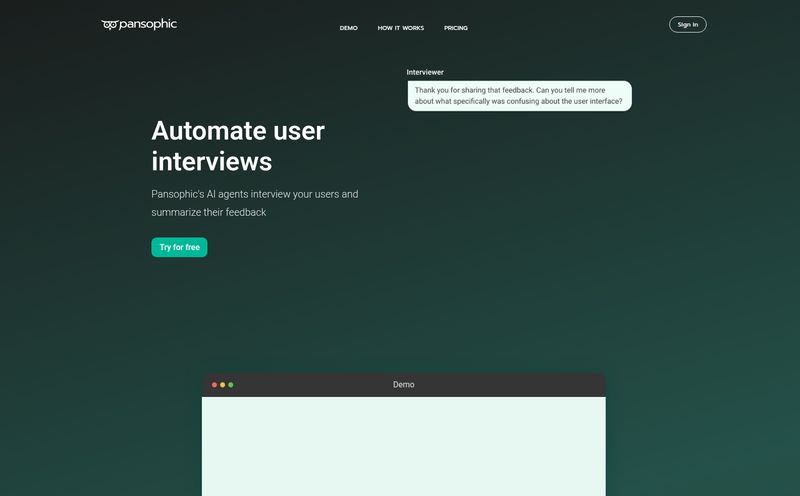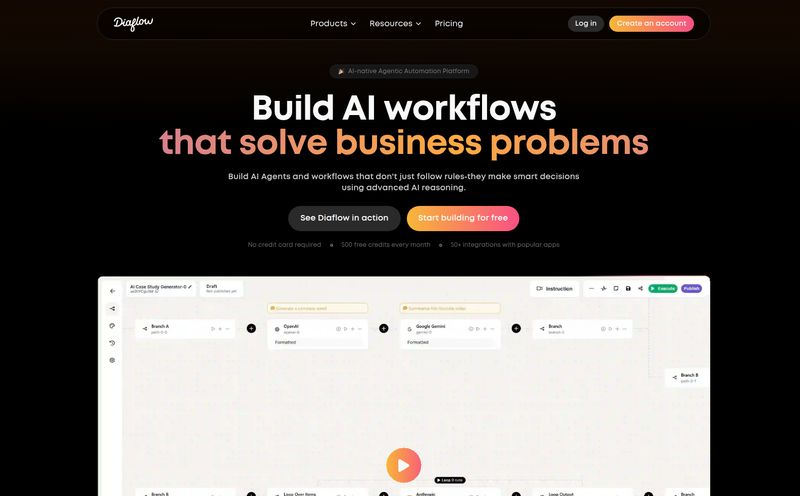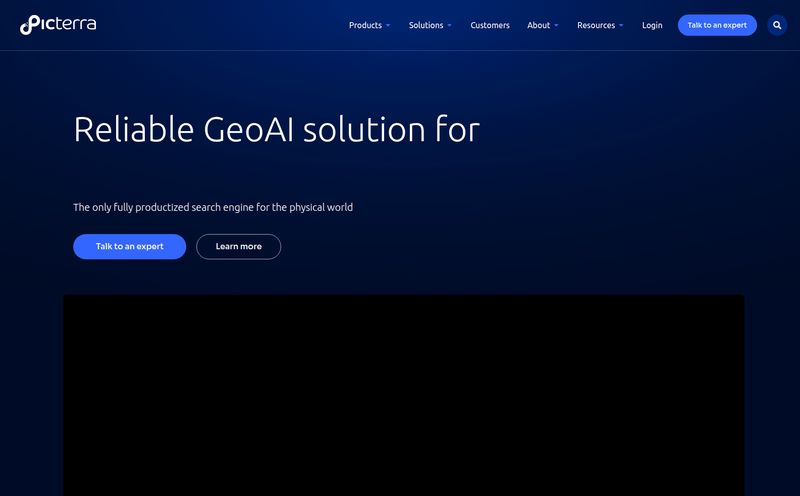You and me. As someone who’s been neck-deep in the SEO and traffic-gen world for years, I've seen countless tools promise to be the next big thing. The 'one-stop-shop' for all your problems. Most of the time, it's just slick marketing wrapped around a familiar-looking dashboard.
But every so often, something catches my eye. Something that doesn't just repackage an old idea but seems to rethink the whole process. Recently, that something was a platform called Faraday. Their headline grabbed me: “Predict customer behavior the speedy way.” Speedy? In the world of data science? That’s a bold claim, and you know I can’t resist a bold claim.
For anyone who's ever tried to build a predictive model from scratch, you know the drill. It’s less ‘sleek data science’ and more ‘digital ditch digging.’ It’s the endless hours spent cleaning data, the headache of identity resolution, and the black art of feature engineering. It's a grind. So when a company says they can take that whole messy notebook full of code and chaos and turn it into a simple API call... I’m intrigued. And a little skeptical, naturally.
Ditching the Jupyter Notebooks for Something... Smarter?
I think the most telling thing on their entire site is a simple side-by-side comparison. On one side, a long, painful checklist of everything we data-minded folks have to do manually. Things like algorithm tuning, validation and reporting, geonormalization... the list goes on. It's basically a perfect summary of my last Tuesday.

Visit Faraday
On the other side? Faraday’s checklist is short, sweet, and already checked off. ✅ Connect to your data. ✅ Automated reporting. ✅ Built-in consumer data. This, right here, is the core promise. It's not about taking away the power, it's about automating the absolute slog. They're aiming to give data science and engineering teams their time back, so they can focus on building cool stuff instead of just prepping the ingredients.
The idea of having 1,500 built-in consumer attributes is particularly interesting. Think about it. That's a massive head start. Instead of needing to license or scrape third-party data and then painstakingly blend it with your own, Faraday seems to have it ready to go. This could dramatically cut down the 'time-to-first-prediction', which is a metric I think we can all get behind.
What Can You Actually Do With Faraday?
Okay, so it's fast. But what does it predict? This isn't about predicting the weather (though that would be nice). It's about tangible, money-making business outcomes. They give a few examples that really hit home.
Nailing Lead Prioritization and Taming the Churn Monster
Every sales team on the planet has this problem. A sea of leads, but which ones are the big fish and which are the minnows? Faraday proposes using its AI agents to predict which leads are most likely to convert. This means your sales team can stop wasting time on dead-ends and focus their energy where it actually counts. On the flip side, it can also predict which existing customers are getting itchy feet and might be ready to churn. Getting ahead of that is, frankly, a business superpower.
From 'Next Best Offer' to 'Next Right Offer'
The concept of the 'next best offer' is as old as marketing itself. But it's often a clumsy guess. Faraday's approach seems more refined. By understanding deep behavioral patterns, the goal is to serve up an offer that feels less like a generic ad and more like a genuinely helpful suggestion. It's the difference between a website shouting at you and one that seems to whisper, “Hey, I thought you might like this.”
Adaptive Discounting: Smarter Than Your Average Coupon
Why give a 20% discount to a customer who would have bought the item anyway for full price? Adaptive discounting is the holy grail for e-commerce margins. The platform can help predict the minimum amount of promotion needed to secure a purchase for a specific customer. That’s not just smart marketing; that's putting money directly back into your pocket.
Built for Builders: A Look at the Faraday API
While they have a point-and-click interface, the real meat on the bones for my fellow tech nerds is the API. This is what separates a simple tool from a true platform. They have this neat little graphic called a “speedrun” that lays out the logic: Connections -> Datasets -> Cohorts -> Outcomes -> Pipelines.
It’s a logical flow that any developer can understand. You connect your data sources (they seem to support warehouses like Snowflake, Redshift, and BigQuery, which is great), define what you’re trying to predict, and let the pipeline do the work. This is crucial. It means you can integrate Faraday’s predictive power directly into your own applications, your own customer experiences, your own internal dashboards. It’s not a closed garden; it’s a set of powerful building blocks.
The Not-So-Secret Ingredients: Data and Responsible AI
Now, let's talk about the elephant in the room with any AI platform: the data and the ethics. It’s a huge topic, and frankly, any company not addressing it in 2024 is waving a massive red flag. I was genuinely pleased to see Faraday putting “Responsible AI” and “Built-in bias management” front and center.
Machine learning models are only as good as the data they're trained on. If that data has historical biases (and it almost always does), your shiny new AI will just automate those biases at scale. A PR nightmare waiting to happen. Faraday claims to have built-in bias detection and mitigation. This is huge. It shows an awareness of the real-world implications of this technology and a commitment to not just building something powerful, but building it right. Props to them for that.
So, What's the Catch? Pricing and Potential Hurdles
Alright, it can't all be sunshine and roses. Every platform has its trade-offs. While the site screams “Get started for free,” I couldn’t find a public pricing page. That usually means we’re in “Schedule a demo” territory, which points towards enterprise-level, custom pricing. So, this probably isn't a tool for a solo bootstrapped startup, but more for established teams that can justify the investment.
There's also the learning curve. Even with a “developer-friendly” API, there will be some ramp-up time. You'll need someone on your team who can speak API and understand the data flows. Finally, you are buying into the Faraday ecosystem. For many, having their data, agents and automation all in one place is a massive pro. For others who want to build every single component from the ground up with 100% customisability, it might feel a bit restrictive. It's a classic build-vs-buy debate.
Final Thoughts: Is Faraday Worth a Shot?
So, back to my original question. Is this the crystal ball we’ve been waiting for?
Maybe. I think Faraday is for a very specific, and growing, type of company. It's for the team that has outgrown basic analytics and is ready for real prediction, but doesn't have a small army of PhD data scientists to build it all from scratch. It’s for engineering and data teams who want to move fast, test hypotheses, and embed intelligence directly into their products without getting bogged down in the MLOps nightmare.
If you value speed, automation, and have the technical chops to plug in an API, I'd say scheduling a demo is a no-brainer. It feels like a genuine step forward in making predictive AI more accessible and, crucially, more responsible.
Frequently Asked Questions about Faraday
- What is Faraday in simple terms?
- Faraday is a platform that helps businesses predict what their customers will do next. It uses AI, a bunch of built-in data, and automation to do the heavy lifting of data science, so companies can quickly add things like lead scoring or personalized offers to their apps and websites through an API.
- Who is the ideal user for Faraday?
- It's primarily built for data science and software engineering teams at companies that want to use predictive analytics. If you have developers who can work with an API and you want to move faster than building everything in-house, Faraday is likely a good fit.
- Does Faraday have a free trial or plan?
- They have a prominent "Get started for free" call to action, which suggests a free tier, trial, or sandbox environment to test the platform. For full pricing details, you'll likely need to schedule a demo with their sales team.
- How does Faraday handle data privacy and AI bias?
- This is a key feature they highlight. The platform includes built-in tools for bias detection and mitigation to promote "Responsible AI." This is designed to help companies build fairer, more ethical models and avoid automating historical biases present in data.
- What kind of data sources can I connect to Faraday?
- Faraday is designed to connect to modern data warehouses. Their site specifically mentions support for platforms like Snowflake, Amazon Redshift, Google BigQuery, and the ability to connect to any data source with a REST API or other standard connections.
- Is Faraday difficult to use?
- It depends on your background. For a marketing manager with no technical skill, it would be challenging. However, for its target audience of developers and data scientists, it's designed to be much easier and faster than building predictive systems from the ground up, thanks to its streamlined API and automation features.
Conclusion
In a sea of over-hyped AI tools, Faraday feels different. It's grounded in solving a real, painful problem: the sheer amount of work it takes to make accurate predictions about customers. By smartly bundling data, automation, and a powerful API, they’ve created something that could genuinely change the game for how businesses deploy machine learning. It's not magic, but it might be the next best thing.



